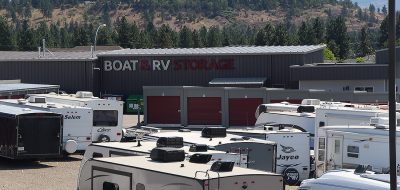 Pretty well every vehicle, regardless of type, carried some form of spare tire in the ‘70’s and 80’s. Today, motor homes have eliminated it in many models and sizes. The larger the tire size and rim diameter, the less chance you are likely to see one today, and probably forever. This is probably due to the following.
Pretty well every vehicle, regardless of type, carried some form of spare tire in the ‘70’s and 80’s. Today, motor homes have eliminated it in many models and sizes. The larger the tire size and rim diameter, the less chance you are likely to see one today, and probably forever. This is probably due to the following.
*Size: A fully inflated tire mounted on a rim takes a considerable space to store. It would also require a large opening access for it to be removed when needed. For example, if it were stored in the basement area of an “A” class coach, it may required an over sized access door to allow it to be removed.
*Weight: The weight of a tire and steel rim varies greatly with the size and type, but it is a substantial weight. This extra weight adds to the GVW (Gross Vehicle Weight) which reduces the allowable carrying weight and potentially increases fuel consumption.
*Cost: An additional tire and rim raises the manufacturer’s wheel set costs almost 17%, and that is not even addressing any possible hold down hardware. In addition to this, the spare yields little when viewed as an added value by potential purchasers. So, if buyers don’t know, or for that matter, care, why supply it.
*Not User Friendly: It may be quite questionable that larger spares are user serviceable. The average motor home owner is not equipped to replace the wheel in the field. Firstly, a suitable bottle jack is generally not included. Secondly, the strength to handle the wheel and remove the lug nuts, may prove a challenge that may exceed the ability of the normal owner.
Many people choose to carry an un-mounted, tire only. This is lighter and stores much better as it can be somewhat flattened. A tire service can quickly swap the flat or damaged one and mount the new. This was my answer also when I had my last coach. The advantages to this solution are, guarantying a perfect match, no waiting and reducing costs of both the tire and shipping. After all, getting a reasonable match is a challenge in many areas, particularly if the tire is a “70” series. This is due to the fact that low profile tires are generally not popular in the commercial truck market and therefore not readily available. Another big advantage to this is, once done, it is final as the tire is mounted on the exact rim involved. A two axle motor home equipped with aluminum wheels has three different wheel configurations. Aluminum deep dish (rear outer), reverse dish (front) and the inner steel. There are three types because aluminum wheels are generally polished only on one side, depending on the intended position.
So, why are people now willing to accept the “no spare”? Are they having less tire issues? Perhaps. Tire monitoring systems, similar to the one shown in the picture, have, and are, becoming very popular. There is no secret that these electronic monitors have substantially reduced on the road tire issues by warning the operator prior to it being a big problem. This early warning information can advise both the individual tire’s current temperature and pressure in real time.
Well, mounted spare, un-mounted spare tire only, or no spare at all. While many models will come without, some may wish to add one anyway. What’s your preference?
With Some Spare Thoughts – Lug_Nut – Peter Mercer






Anonymous
I purchased a used class a, it has a huge fully inflated spare in the basement. My quandry, how the heck do i get it out and what do i do with it?
It takes up an immense amount of space & weight.
Ugh
Pingback: flyttstädning stockholm
Pingback: הובלות
Pingback: photography website builder
Paul Kunkel
My ’89 Allegro came with a Michellin spare which has hardly seen the light of day nevermind been on the ground. However, it has always given me piece of mind, knowing that it is there. It sits amidship accessable from the drivers forward compartment & I pull it out to air it up once a year. The rubber/sidewalls still look like new & I presume that it would still be serviceable as a spare should I ever need it. I really should replace it one of these days!
Lug_Nut
Rick, Not knowing the type or model, I will take a shot. If your unit has all steel wheels, that is not aluminum, the spare will fit all positions. The dual inside is just the same wheel as the outside just turned around. The inner wheels on your rear axle are probably equipped with valve stem extension hoses that allow you to check and fill the inners easier. If you replaced one, you would remove the extension and screw it in the spare. I hope that helps you with your question.
Rick
I am new at RVing. I purchased my RV and it has a spare under the rear of the coach. I have duelly rear tires. My question is will the spare fit on either the outside or inside? Also I only see one valve stem that I can see, will it air both tires? I do feel better about having a spare, although have not figured out if I have a jacket or lug wrench. Any help would be appreciated.
Lori
A spare is a must! …as are all the other tools to change a tire. Both times I’ve called out road service they didn’t bring a spare and fortunately I had one. I’m not physically up to changing an RV tire, but I have the knowledge and tools in case someone stronger is available. I have Good Sams Road Service, and they’re good. Unfortunately if you’re out in the boonies, you’re at the mercy of what’s available. Pack for success!
TXBrad
My vote is to carry a “correct size tire” & a valve steem. My class came w/ spare tire & wheel. Takes up storage space & very,very hard to check air pressure ( yes , seen an “extension” ??).
For a “younger” do-it-yourselfer, not only need to jack it up & block wheels, but good luck removing lug-nuts. ( Been torqued @ factory & probably have some rust/corrosion ) When installing spare, need to torque lug-nuts. Very important !
Wheels can come loose & off.
Drew Mueller
In my opinion, it simply is not prudent to travel without a mounted spare. The more common sizes will be scarce anywhere. (Have you ever gone to an outlet to find size 9 1/2 shoes?- They probably are out of stock- but the’ve got lots of 7’s and 13’s!) From experience, the outfit that is going to help you with your flat is going to ask “Do you have a spare?” It’s rare, but rims can develop leaks as well.
Lug_Nut
Jim Norman, It is a real bonus that your 2008 Itasca came with a spare and it sounds like you may be able to replace it yourself. Yes the jacks could do the lifting. Don’t forget to carry chocks to block the wheels for such a job, particularly if it is a rear flat. Thanks for your great input.
jjtotten, Experience is a great teacher. I guess the ssue arise when trying to find a like tire. I’ve heard of this happening to many. Thanks for your comments.
Lug_Nut
Don, I would not be so hard on the dealer as most manufacturers just don’t provide either a spare of any type, or a place to put it.
Mac, It certainly becomes a wise move when you need it one day. Thanks for the input.
Darrel, Mobile tire service is available throughout every state, the right tire for your rig, however, perhaps not. Hopefully your PressurePro will warn you in time to save the tire.
jjtotten
I had never thought about the fact that some rigs do not come with a spare until an experience out in the middle of nowhere on the Navajo reservation. I went out early on Sunday morning to some meetings in Page Arizona and there was a nice & large motor home sitting only partly off the pavement with a flat tire. The trip lasted the whole day and upon returning that evening the motor home was still there. And it was still there on Monday morning still apparently waiting for a spare. Although the tires and wheels are very large and very heavy I am sure that the owner would have given his eye teeth for on about that time. I of course don’t know if the owner would have been able to mount the tire on the MH or not but I am sure he would have tried if he had one.
Jim Norman
Our 2008 Itasca came with a fullsize mounted spare. It is carried in a compartment accessed from the drivers (road) side of the vehicle. I believe I COULD effect the change, but then again…
The levelers WILL lift my rig, not a good idea, but better than nothing? I have lug wrenches and an extension that will give me the required leverage.
I am thinking of developing a rear bumper mount utilizing the hitch and using the resultant empty compartment for other storage. Tire mount would not be very difficult to build. Weight distribution would not be greatly effected as the current location is at the rear of the rig.
Comments??
I wonder a bit about carrying a spare. We own about 20 light trucks and we almost never have a tire problem other than wearout. I expect that I will be changing the tires on my rig long before I get to the regroove point simply do to age. I hate to think of the spares we have sent off to the trade lot on trucks we traded having never roated the spareto the ground.
Jim
Darrel
I’m assuming that tire repair trucks are readily available in most parts of the US as they are around here. Since I don’t have the tools to change a tire on the road and my tires are a common size there is not a very good reason to carry a spare. We use and sell the PressurePro Tire Monitoring System. The monitor is $190.00 and the sensors are $50.00 per tire. The PressurePro system is very easy to install and it works very well. Thanks.
Mac McClellan
Our old Southwind has a mounted spare under the rear; however, I’d be just as happy with an unmounted spare. I definately want some kind of spare tire because it’s hard to get a match for existing tires, even popular sizes.
We have Michelin 225/70R19.5 XRV tires. This is a common size RV tire, yet I’ve had more than one Michelin dealer tell me they don’t have any. The Michelin dealer in Grants Pass even told me they “can’t get them” and tried to sell me two truck tires instead. No thanks! My RV rides rough enough already! I finally found a good tire shop at Seven Feathers truck stop in Canyonville, and drove the extra distance to buy the right tires.
Don Mundth
I traded a Pace Arrow Motor home, which had a like new spare tire on it, for a new Damon Challenger. I never even gave a thought that the Damon would not have a spare. I didn’t even realize it until after I took delivery of the new unit. Had I been aware that RV Dealers were not ordering spare tires mine would have had one. I would have at least taken the spare from the Pace Arrow if I had known.
I am still burning and feel that my RV Dealer ripped me off by not ordering a spare. I have have had two instances with where I needed a spare. One where I had a spare and most recently one with the Damon where I did not have a spare.
When I had the spare I was on the road again in an hour or so. The most recent incident caused a two day delay while the tire dealer ordered a new tire for me. I was literally dead in the water. Fortunately I was able to camp in a park not too far from the tire dealer. It made me even more disgusted than ever with my RV Dealer.
Lug_Nut
David, Thank you for being so observant. Who would think another company in the tire monitor business would have the double “T” site. I’ve made the correction on the link.
david
The link should be smartire.com [one T not two].
Lug_Nut
John J., Thanks for the product precaution update. Hopefully others will read your comments. Prehaps it would be a good idea to post it on the forum, if you have not already done this.
Rob
I don’t carry a spare tire. Instead I rely on my Road Service (Coach Connect). If I was to travel somewhere where obtaining a tire replacement might be difficult (Alaska or Mexico) I would carry a spare.
Lug_Nut
Orv, Yes, the unmounted spare is a great answer. Good to hear your comment on the Pressure Pro. Thanks for your input.
John Johnson
A word of caution about tire monitoring systems: both Doran and Pressure Pro present a problem if the tow vehicle has aluminum valve stems, as is common on Jeep products with factor installed tire pressure monitoring systems. The brass inner core of the Doran or Pressure Pro systems monitors will cause corrosion on the aluminum stems and ultimately cause the failure of the aluminum valve stem. Happend to after four months of installation. Fortunately, it occurred when the Jeep Grand Cherokee was not being towed so there was no major damage. Doran acknowledged the problem and recommends removing the monitors monthy and applying anti-seize lubricants to the stems.
Lug_Nut
Charley, I fully agree. An unmounted spare make good sense if you have the room to carry it. I had one on my last coach.
Orv Hazelton
I am firmly in the “must have a spare” camp: I always carry an unmounted matching spare with me. . . usually the “best” of any group of tires I’ve replaced. I would caution others, however: check your spare frequently for air level and tire condition. I found that mine had “dry-rotted” several years ago the hard way, just as I needed it! I use the Pressure Pro tire monitoring system and am thoroughly satisfied with it. Having a safe trip helps ensure having a pleasant trip. As always, oRV
Lug_Nut
Dave, There are two ways you could go. Smartire, requires removing the tires to install. Measures both internal temperature and pressures. Pressure Pro, replaces the valve cap. Somewhat subject to theft. Locks are available. I have heard good reports on them as being efficient and accurate.
Charley
An unmounted spare seems the most logical and practical solution. Covers all eventualities and is probably the least expensive in the long run.
Dave Durham
Hi Peter,
I’m interested in the after market installation of the tire monitoring systems. Any idea
about the cost for a tag axial coach. Thanks for all of your informative posts.
Dave D.